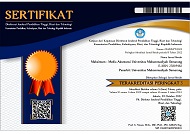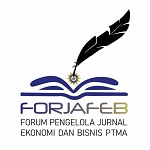Differences In The Use of Diagnostic Budget and The Use of Interactive Budget: Case Study of SMEs in Palembang City
(1) Universitas Sriwijaya
(2) Universitas Sriwijaya
(3) Universitas Sriwijaya
(*) Corresponding Author
Abstract
This study aims for analyzing influence styles, use budget diagnostics and interactive proxies for performance companies all at once. For comparing styles, use budget diagnostics and interactive proxies for SMEs in Palembang City. The type of data used is the primary data result of a spreading interview containing a questionnaire and alternative answers given to the respondent, which is SME managers and workers in Palembang City. Population study: there are 155,467 SMEs in Palembang City. Taking samples uses snowball sampling methods and techniques, which yield a determinant sample that yields the total sample of as many as 100 SMEs. Research data analysis techniques This is using the Software Statistical Program for Social (SPSS) version 27 with descriptive statistics and simple linear regression. Research results this show that style use budget diagnostic and interactive no influential performance company, use budget in a manner diagnostic more lots used compared to with use budget in a manner interactive.
Keywords
Full Text:
PDFReferences
Artha Purnama, R., & Fadjrih Asyik, N. (2020). Pengaruh Partisipasi Penyusunan Anggaran Terhadap Kinerja Manajerial dengan Komitmen Organisasi Variabel Moderating Nur Fadjrih Asyik Sekolah Tinggi Ilmu Ekonomi Indonesia (STIESIA) Surabaya.
Bisbe, J., Kruis, A. M., & Madini, P. (2019). Coercive, enabling, diagnostic, and interactive control: Untangling the threads of their connections. Journal of Accounting Literature, 43, 124–144. https://doi.org/10.1016/j.acclit.2019.10.001
Bisbe, J., & Otley, D. (2004). The effects of the interactive use of management control systems on product innovation. Accounting, Organizations and Society, 29(8), 709–737. https://doi.org/10.1016/j.aos.2003.10.010
Chong, K. M., & Mahama, H. (2014). The impact of interactive and diagnostic uses of budgets on team effectiveness. Management Accounting Research, 25(3), 206–222. https://doi.org/10.1016/j.mar.2013.10.008
Cools, M., Stouthuysen, K., & van den Abbeele, A. G. H. L. (2012). Management Control for Stimulating Different Types of Creativity: The Role of Budgets. SSRN Electronic Journal. https://doi.org/10.2139/ssrn.1899409
Dinas Koperasi dan Usaha Kecil dan Menengah Kota Palembang. (2020). Pemerintah Kota Palembang Rencana Kerja Dinas Koperasi dan UKM Kota Palembang 2022.
Farida, M. K. D. N. (2015). Pengaruh Kompetensi Komite Audit, Aktivitas Komite Audit Dan Kepemilikan Institusional Terhadap Manajemen Laba. Jurnal Akuntansi Indonesia, 4(1), 66. https://doi.org/10.30659/jai.4.1.66-82
Frezatti, F., de Souza Bido, D., da Cruz, A. P. C., & Machado, M. J. C. (2017). Impacts of interactive and diagnostic control system use on the innovation process. BAR - Brazilian Administration Review, 14(3). https://doi.org/10.1590/1807-7692bar2017160087
Handayani, S., & Arianty, N. (2010). Pengaruh Anggaran Partisipatif Melalui Budaya Organisasi, Gaya Manajemen dan Motivasi Kerja Terhadap Kinerja Manajerial Dan Kepuasan Kerja. JUrnal Riset Akuntansi Dan Bisnis, 10(1), 104–117.
Hasanuh, N., & Nawawi, A. (2016). Pengaruh Pengendalian Diagnostik Terhadap Kinerja Karyawan (Studi Kasus Pada PT. Bravo Satya Kencana Karawang). Accounthink : Journal of Accounting and Finance, 1(01), 39–48. https://doi.org/10.35706/acc.v1i01.441
Henri, J. F. (2006). Management control systems and strategy: A resource-based perspective. Accounting, Organizations and Society, 31(6), 529–558. https://doi.org/10.1016/j.aos.2005.07.001
Hofmann, S., Wald, A., & Gleich, R. (2012). Determinants and effects of the diagnostic and interactive use of control systems: An empirical analysis on the use of budgets. Journal of Management Control, 23(3), 153–182. https://doi.org/10.1007/s00187-012-0156-9
Islam, J., & Hu, H. (2012). A review of literature on contingency theory in managerial accounting. African Journal of Business Management, 6(15), 5159–5164. https://doi.org/10.5897/ajbm11.2764
Jainuri, M. (2014). Analisis Data Komparatif (T-TEST).
Jiao, L., Harrison, G., & Chen, J. (2022). Revenue growth in not-for-profit organisations: The effects of interactive and diagnostic controls and organisational culture. Accounting and Finance. https://doi.org/10.1111/acfi.12960
Kaveski, I. D. S., Beuren, I. M., Gomes, T., & Lavarda, C. E. F. (2021). Influence of the diagnostic and interactive use of the budget on managerial performance mediated by organizational commitment. Brazilian Business Review, 18(1), 82–100. https://doi.org/10.15728/BBR.2021.18.1.5
Lekatompessy, & Jantje, E. (2007). Hirarki Akuntan Sebagai Moderasi Hubungan Antara Komitmen Afektif dan Berkelanjutan dengan Komitmen Profesional. Jurnal Manajemen, Akuntansi dan Sistem Informasi (Vol. 7). Magister Sains Akuntansi Universitas Diponegoro.
Lily Indarto, S., & Dyah Ayu, S. (2011). Pengaruh Partisipasi Dalam Penyusunan Anggaran Terhadap Kinerja Manajerial Perusahaan Melalui Kecukupan Anggaran. Seri Kajian Ilmiah, 14(1), 33–34.
Lukviarman, N. (2016). Corporate Governance : Menuju Penguatan Konseptual dan Implementasi di Indonesia. Era Adicitra Intermedia.
Mubarok, A., & Faqihudin, M. (2011). Pengelolaan Keuangan untuk Usaha Kecil dan Menengah (A. Mubarok & M. Faqihudin, Eds.; 1st ed.). Suluh Media.
Müller-Stewens, B., Widener, S. K., Möller, K., & Steinmann, J. C. (2020). The role of diagnostic and interactive control uses in innovation. Accounting, Organizations and Society, 80(xxxx). https://doi.org/10.1016/j.aos.2019.101078
Nadiyah, U. (2018). Analisis Perhitungan Anggaran Penjualan Dalam Evaluasi Kinerja Manajemen Pada Depot Kayu dan Toko Bangunan Usaha Bersama Palembang. 1–6.
Nurdiani, N. (2014). Teknik Sampling Snowball Dalam Penelitian Lapangan (Vol. 5, Issue 2).
Putu, N., Eka, D., Sugiarthi, R., & Supadmi, N. L. (2014). Pengaruh PAD, DAU dan SILPA Pada Belanja Modal dengan Pertumbuhan Ekonomi Sebagai Pemoderasi (Vol. 7).
Sakka, O., Barki, H., & Côté, L. (2013). Interactive and diagnostic uses of management control systems in IS projects: Antecedents and their impact on performance. Information and Management, 50(6), 265–274. https://doi.org/10.1016/j.im.2013.02.008
Simons, R. (2000). Performance Measurement & Control System For Implementing Strategy. Issues in Accounting Education, 15(1).
Simons, R., Anthony, R., Argyris, C., Bower, J., Christensen, C. R., Christiansen, E., Eccles, R., & Stevenson, H. (1990). The Role Of Management Control System In Competitive Advantage: New Perspectives. In Organizations andSociety (Vol. 15, Issue 112).
Su, S., Baird, K., & Schoch, H. (2015). The moderating effect of organisational life cycle stages on the association between the interactive and diagnostic approaches to using controls with organisational performance. Management Accounting Research, 26, 40–53. https://doi.org/10.1016/j.mar.2014.09.001
Wityaningsih, D. (2017). Pengaruh Penekanan Anggaran Pada Kinerja Aparatur Dengan Model Perencanaan Anggaran Sebagai Variabel Pemediasi.
Yetano, A., Matsuo, T., & Oura, K. (2021). Diagnostic and Interactive Use of PMM by Japanese Local Governments: Does the Context Affect the Fitness of Use? Public Performance and Management Review, 44(1), 28–57. https://doi.org/10.1080/15309576.2020.1817108
Yustrianthe, R. H. (2012). Beberapa Faktor Yang Mempengaruhi Audit Judgment Auditor Pemerintah. Jurnal Dinamika Akuntansi, 4(2). https://doi.org/10.15294/jda.v4i2.
Article Metrics
Abstract view : 282 timesPDF - 3 times
DOI: https://doi.org/10.26714/mki.14.1.2024.48-58
Refbacks
- There are currently no refbacks.
-----------------------------------------------------------------------------------------------------------------------------------------------------------------------------------
 | MAKSIMUM: Media Akuntansi Universitas Muhammadiyah Semarang |
![]()
Maksimum: Media Akuntansi Universitas Muhammadiyah Semarang is licensed under a Creative Commons Attribution Attribution-NonCommercial-NoDerivatives 4.0 International License.

















